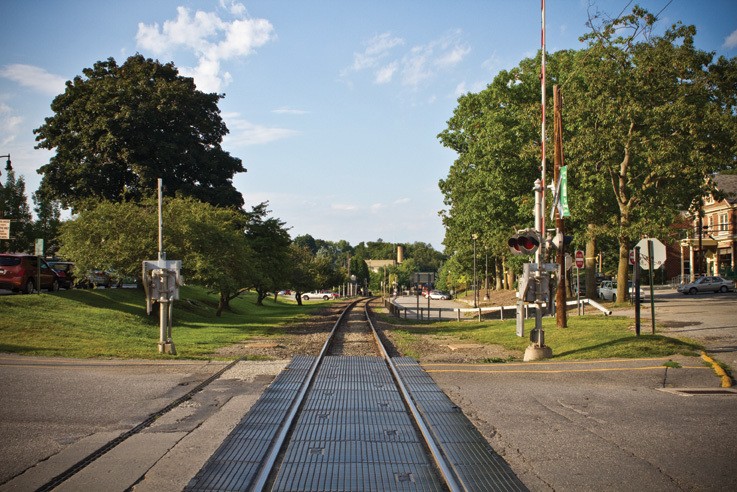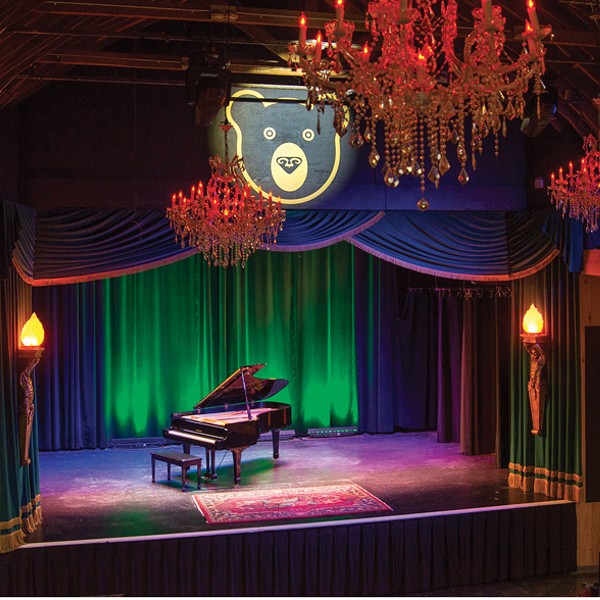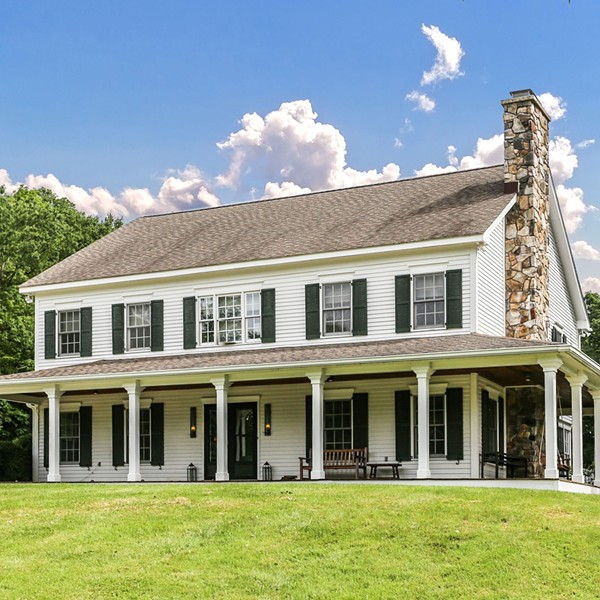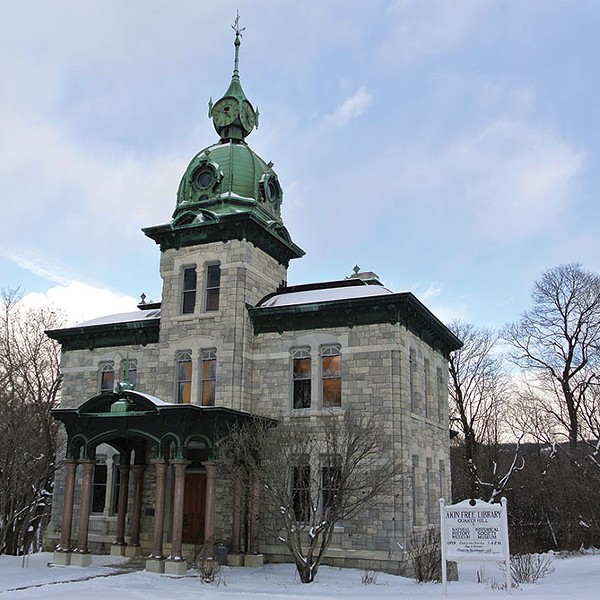Right off the beaten path, or rather wrapped around the sides of a few of them in the southeast corner of Dutchess County, is the almost implausibly storied town of Pawling. Out the window of a train on the Metro-North Harlem line, which runs through the town’s small village, or in a car buzzing down Route 22 bound for the Taconic Parkway, Pawling could whiz by without leaving much of an impression. Stop, and it’s a different story.
Historically, Pawling has seen many travelers and migrants. Before its first European founders, Town Historian Robert Reilly writes, Pawling was mostly just passed through by journeying Mahikan Indians, who roamed the area that is now Dutchess County. While two burial sights have been discovered in Pawling, Reilly says there is little evidence to conclude they lived there.
In 1728 the Quakers arrived, settling the area called “the back lots” atop what is now Quaker Hill. In 1742 the growing community built the Oblong Meeting House. It was in that unassuming meeting house, nearly a century before Abraham Lincoln delivered the Emancipation Proclamation, that the Pawling Quakers voiced the first official opposition to the institution of slavery in the Colonies, stating that if God resides in everyone, enslaving anyone is to enslave God.
During the winter of 1778-79, the Oblong Meeting House was commandeered by General George Washington for use as a make shift hospital. Washington himself stayed in the nearby John Kane House, which he made his headquarters while positioning forces. Both buildings, along with many others in Pawling, are now recognized as protected historic places.
When the Harlem train line was extended to Pawling in 1848, the once primarily agricultural community was given a new source of influence as travel to and from New York City became much easier. The short commute by rail brought with it powerful new residents and visitors.
The connection to the city only 70 miles south of the town remains extremely important. “Having that stop is critical to Pawling’s development,” says Chamber of Commerce President Peter Cris, standing on the sidewalk of the village’s postcard-worthy main street, Charles Colman Boulevard, near the historic train station that serves as the Chamber’s office.
When entering the village by train, Pawling’s architecture and overall aesthetic feels very much like a piece of New England. The large and striking brick building known as the Dutcher House, which contains a number of Pawling’s storefronts, is the centerpiece of the village.
In the southern end of the Dutcher House is the McKinney & Doyle restaurant and bakery. Seemingly all day long, from the morning cup of coffee to the one with desert, the establishment is busy. The bakery offers a casual but high-end experience while the dinning room puts out an extremely long and varied menu of dishes that have received high praise from Zagat’s, as well as other reviewers.
While the village does not have a long line of storefronts and can utilize only the side of the road opposite the tracks, nothing seems superfluous or repeated. The Annex Florist, also in the Dutcher provides packed window boxes for all the building’s stores. Beyond the Dutcher one can get unpretentious, thin-crust pizza at Mama Pizza II or order homemade Mexican food from thewhite board at the El Quetzal restaurant and deli.
The Pawling Green
Despite the recession, Pawling is working on a number of substantial development projects. Cris is currently courting a number of hospitals and investors for the creation of a 66,000-square foot medical office building on Route 22 for what he says is a medically undeserved community. But the most immediate and substantial project is the Pawling Green, which is expected to break ground on Charles Colman Boulevard this month.
The Pawling Community Fund was able to privately raise over $2 million for the green, which will transform the landscaping between and around the boulevard and the railroad into a pedestrian-friendly park. Cris believes that a more walkable and attractive village will attract visitors as well as further development.
With the influx of residents from New York City, from the super rich—four billionaires currently call Quaker Hill home, or a home—to young commuter families reliant on the train for work, the population of Pawling has actually continued to grow, Cris says, a trend that runs contrary to nearly all the other local municipalities.
(Pawling has a long legacy of rich and famous full or part-time residents, including former Governor Thomas E. Dewey, Edward R. Murrow, and Dr. Norman Vincant Pearl, who established the Center for Positive Thinking on Main Street, an institution that still attracts many visitors.)
Throughout the Hudson Valley, this northern migration has often beenscorned by those born and raised in the country. Cris admits this culture clash exists in Pawling and surrounding Dutchess. Cris says there has been resistance from some native Pawling residents and business owners to the Pawling Green and a collaborative business development plan for the village, but he’s confident that, eventually, as the town improves, everyone will begin to see the value. “If you get involved in the change you can affect the quality of that change,” says Cris.
The Great Swamp
Beyond the draw created by history and business, travelers also come to Pawling to experience its unique natural setting, situated as it is in the center of the Great Swamp, a 6,000-acre ecosystem that stretches through Dutchess and Putnam Counties for 20 miles.
The village of Pawling is situated right in the center of the the Great Swamp’s watershed, which has a total coverage of 63,000 acres. From the divide in Pawling, the swamp flows in two different directions. The Swamp River flows north from the village into the Ten Mile and Housatonic Rivers before eventually emptying into the Long Island Sound. To the south, the swamp flows into the Croton Reservoir system, the water supply for millions in New York City.
But aside from all the statistics, Mac Rand, owner of Great Blue Outfitters, says the allure of the Great Swamp is simple—it’s beautiful. He recalled the day, when rowing slowly down the river between reeds and thick forest, he saw the heron he would name his new store after. Rand moved to Pawling four years ago from Carmel, and says the first time he kayaked the swamp’s south passage with his son he was enchanted.
Rand retired from his previous careers as a teaching science and running a Canadian summer camp to open Great Blue Outfitters off Route 22 at Pawling’s southern border with Patterson, out of which Rand leads unreasonably affordable tours and rents equipment for those looking to kayak or canoe the Swamp.
Rand says this time of year the Swamp is pretty dry and boaters usually have to get out and get their feet wet to climb around an obstructive beaver dam or two, but that’s all part of the experience. “A lot of people, even local people, don’t know about the Great Swamp,” says Rand, pacing around his store one afternoon. A three-time competitor in Ironman triathlons, he’s not the type to stand still long. “I think because we want to protect places like that, we need people to see them and experience them, in order to develop a relationship with the place.”
Since moving to the area Rand has become a board member of the organization Friends of the Great Swamp (FrOGS). FrOGS’s mission is to undertake activities “to conserve, protect, and promote the functions, values and integrity of the Great Swamp wetland and its watersheds in Putnam and Dutchess counties.”
The group of volunteers has been operating since 1990, providing environmental education opportunities, promoting new scientific research in the Swamp, working on conservation land-use planning with landowners and local governments, and supporting sustainable use of the Swamp and its watershed for nonintrusive recreation uses.
One of the organization’s largest accomplishments to date occurred in 2003 when FrOGS, along with coalition of other partners, procured a North American Wetlands Conservation Act grant to acquire lands and conservation easements in what is considered the widest and most vulnerable part of the Great Swamp.
“Working against time and skyrocketing land prices,” a FrOGS statement reads, “FrOGS, the Nature Conservancy, the State of New York DEC, the Town of Patterson, and the Putnam County Land Trust have acquired 471 new acres and easements on an additional 112 acres more.”
FrOGS has work to do with so much area to cover and all the habitat for hundreds of species of mammals, reptiles, and birds—39 of which are listed as rare in New York. Rand believes the cultural attitude toward the value of wetland resources has shifted in FrOGS’s favor, and now the organization’s best tool is education.
Nature lovers are not without options in Dutchess County. Along with the opportunities provided by the Swamp, the Appalachian Trail, which runs from Georga’s Springer Mountain to Mount Katahdin in northern Maine, passes through Pawling. While some “through hikers” do the entire trail over the course of the spring and summer, Rand says jumping on the trail for a few miles in town is a worthwhile experience.
Through hikers often take a break in Pawling. After grabbing a bite to eat they often stop into Great Blue, or Rand sees them about, as they’re pretty easy to spot. “I tell through hikers, ‘The good news is you’ve got 1,400 miles south of you,” Rand says with a grin. “The bad news is, you’ve got 700 more to go.” (Most through hikers start in Georgia and work their way north.) Rand says he started his business a year ago not just because he loves nature and being active but to get others out as well. “I feel a very emotional attachment to the outdoors,” Rand said. “We miss a lot because our lifestyle is so frantic. I’m trying to get people out to experience it and educate them a little.”
A tradition of service
Back in civilization, the roads wind away from Pawling to other seemingly inconspicuous dots on the map. Along the Taconic Parkway, flying by at 55 mph, is the small hamlet of Hopewell Junction in the town of Fishkill. Commuters may know it for its large and easily accessible gas station, but most aren’t aware that just down the road one of the town’s oldest farms, thick with historical relevance, and now in its third generation, is beginning a new chapter.
“I think Fishkill Farms is one of those diamonds people just don’t know about,” says Dutchess County Chamber of Commerce President Charles North. “Not only is it rich in produce, but it’s also rich in culture. It is fantastic having that in our backyard.” In August, the farm held a ribbon cutting for its new barn that was attended by numerous local and state officials. Last year, a disastrous fire claimed the old barn, which along with providing cold storage for produce, housed numerous Morgenthau family heirlooms.
Started in 1914 by Henry Morgenthau Jr., Fishkill Farms was a fruit orchard, dairy, chicken, and vegetable farm. Like many farms in the area, it soon became primarily an apple orchard. Henry Morgenthau, a Cornell graduate, quickly began to split his time between the farm and public service. He was appointed chairman of the Agricultural Advisory Commission in 1928 and the state’s Conservation Commissioner in 1930. His work, a farm history tells, “paved the way for the Federal Civilian Conservation Corps, an organization that sent many young, urban men out into the country to save forests and farmland.”
Franklin Delano Roosevelt, then governor of New York, and living in nearby Hyde Park, was a friend of Morgenthau. When elected president, FDR appointed the Hopewell farmer Chairman of the Farm Credit Administration, which saved many family farms from foreclosure. He was appointed secretary of the Treasury in 1934, where he served for the rest of the Roosevelt presidency.
FDR frequented Fishkill Farms throughout his terms in office. On one occasion, in June 1942, Prime Minister Winston Churchill came with him. According to a family history provided by the farm, “Henry’s son Robert, then a 22-year-old Navy ensign home on leave from his destroyer, served the president and prime minister mint juleps in the garden as they discussed the course they would take in the war.”
In the 1960s, after the passing of the patriarch, operation of the 270-acre farm was passed to Robert Morgenthau. After his service in World War II, Robert, like his father, turned to the public sector. He eventually became US Attorney in New York State under President Kennedy, and later, Manhattan’s district attorney, the job he has held for 35 years. “When you visit it,” North says, “it’s kind of like visiting sacred ground.” Tours of the farm go on during the week and include old film of some of the more memorable events, including Churchill’s visit with FDR.
The farm diversified again under Robert’s watch. While continuing the apple orchard, he reintroduced other produce. In the 1990s the family began leasing the farm to other growers when the family’s long time manager Ray Morris retired. In 2008 Robert and his son Josh took back over farm operations and a plan to take the farm organic has begun in earnest. New projects include reintroducing 800 free-range chickens, starting a large organic garden, and even the complicated process of taking sections of the orchards off pesticides.
Then, in the summer of 2009, what is believed to have been an electrical fire broke out in the large barn, billowing thick black smoke that could be seen for miles and completely destroying the structure.
While the fire took away a piece of the farm’s history, Fishkill Farms Marketing Manager Hannah Geller says the new pole barn stays true to the farm’s old aesthetic while offering a number of modern improvements. The farm recently received a grant from the US Department of Agriculture’s Rural Energy for America Program to install solar panels on the roof of the barn, something she said the Morgenthaus see as a part of their plan to make the farm “greener.” The solar array will run the barn and cold storage room, and is expected to meet over 50 percent of the farm’s energy needs.
“In the long run,” Geller says, “hopefully [becoming certified organic] will be rewarding financially and ethically. Most farms here don’t have that in mind. That’s the most exciting thing to me.”
Hopewell Junction and Pawling sit quietly at the bottom of Dutchess County. To some, the towns are just road signs passed by in cars and trains on paths to and from busy lives. To those who may take a moment to stop, they can be much more.
RESOURCES
The Annex Florist (845) 855-9612
Center for Positive Thinking www.guideposts.org
Dutchess County Chamber of Commerce www.dutchesscountyregionalchamber.org
Fishkill Farms www.fishkillfarms.com
Friends of the Great Swamp www.frogs-ny.org/
Great Blue Outfitters www.greatblueoutfitters.com
John Kane House www.pawling-history.org
Mama Pizza II (845) 855-9270
McKinney & Doyle www.mckinneyanddoyle.com
Pawling Chamber of Commerce www.pawlingchamber.org





















